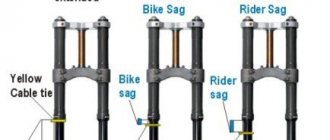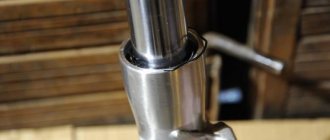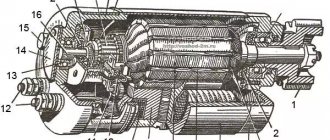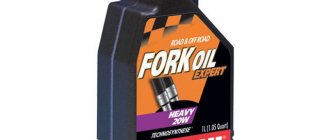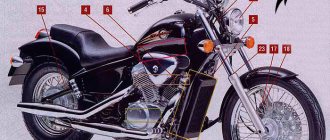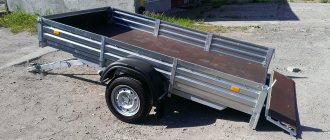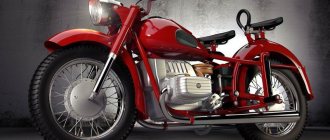Preparing the vehicle
You should not leave your motorcycle in open parking lots. And they can steal it, and the climatic conditions do not allow it, so even a guarded open parking lot is still not suitable. If it is not possible to leave your equipment for the winter in a warm and well-equipped garage, you can look for any other suitable room. For example, you can preserve your motorcycle in a cold garage. What will be the procedure in such cases?
In general, the same rules will apply here as for storing cars that are not planned to be used for a long period of time.
First you need to find a place to install the step, and also place a small board under it. A suitable piece of wood should also be placed under the front wheel. You need to remove the battery from the motorcycle and wash the vehicle. For this purpose, car body shampoos are usually used. But if the motorcycle is not very dirty, you can cope with the task with ordinary car cleaning wipes. All metal parts require anti-corrosion treatment. The rubber parts of a motorcycle and even its tires need to be treated with silicone spray or a special polish that is produced for tires. The leather seat of a motorcycle is processed separately. It requires a water repellent spray. Do not use leather polish for maintenance. In this case, the seat will be very slippery for a long period, and this is unsafe.
Already at the final stage you can apply wax polish. They use the one that is used to treat cars for storage; this composition is intended for glossy body surfaces.
Some car enthusiasts use silicone grease to coat their motorcycle. It must be applied in the same way as polish, that is, on a clean and dry (this is important) surface and preferably in a thick layer.
In principle, both polish and silicone lubricant give the same effect; the choice depends on personal preferences, who is more comfortable using which. Another argument in support of silicone is its ability to be used to protect rubber and wiring. This lubricant pushes out accumulated moisture from all secluded places, and after hardening it forms a film that prevents the liquid from seeping further.
Preserving a motorcycle for the winter in a cold garage
The last warm days are coming to an end and it’s time to think about storing your motorcycle for the winter. Unfortunately, motorized vehicles, unlike four-wheeled vehicles, are not suitable for traveling on icy and snowy roads. Many insufficiently responsible motorcyclists without any hesitation leave their horse to spend the winter in a parking lot or in an unheated garage without prior preparation. It is worth understanding that this approach is fundamentally wrong. At low temperatures and changes, the bike's systems deteriorate and subsequently the service life of the vehicle will be much shorter.
This article is dedicated to responsible owners who are ready to approach the wintering of their iron friend with great care. Considering that most garages still do not have heating, we will talk about preserving the motorcycle for the winter and storing it in an unheated garage. Below you will find answers to the following questions:
- How to preserve a motorcycle for the winter?
- What details should you pay attention to?
Basic motorcycle preservation work
By the end of the season, the oil in the engine is probably already old; it needs to be drained and replaced with new one. You can only use oil of the same type, that is, with the same characteristics. But why can't you leave the old oil? Because it will quickly begin to separate out lower fractions. They have the property of settling below, that is, at the bottom of the crater. And there they block the passages of two systems at once - the oil filter and lubricant. In addition, old oil contains exhaust gases (they look like clusters of bubbles). These substances lead to the activation of corrosion processes.
After changing the oil, you need to install the motorcycle on a prepared central support to make it more convenient to carry out further work. After this, you need to unscrew the spark plugs. You need to pour a little oil into each of the cylinders, literally a few drops, again of the same type and viscosity as the oil poured into the engine. Then you need to screw the spark plugs into place and turn the pistons using the kickstarter.
What to do with a removed battery? If the motorcycle is parked in a cold garage, then the battery must definitely be moved to a warm room. Charge it about once a month. In general, this depends on the characteristics of the battery, so you need to do as the manufacturer advises in the instructions. Charging time is about 10 hours. If you use modern chargers, you need to monitor the moment when they indicate the end of charging. Anyone who has studied the rules for storing cars in winter knows this procedure.
Another significant point is the blockage of the muffler exhaust hole. This is also done to prevent corrosion. A plugged hole will prevent moisture from settling inside the exhaust system. No special equipment is needed for sealing; a plastic bag will do.
Preservation of tires raises no less questions. Some motorcyclists believe that it is necessary to reduce the tire pressure by about 40-50%. Others believe that the tires need to be pumped up even more. In fact, it all depends on the storage conditions. It is not always possible for a car enthusiast to mount a motorcycle on a center stand. If the vehicle will sit on wheels all winter, then the tires need to be slightly inflated so that they do not deform under the weight of the motorcycle. And, as mentioned above, to prevent the tires from drying out, they are treated with a special agent.
At the end, the motorcycle must be covered with a cover, but not to the very bottom, that is, a small gap is left to ensure good ventilation. You can use a tarpaulin as a cover. And under no circumstances should you use polymer films, such as the same polyethylene that is widely used in construction, since with temperature changes, especially with a sharp drop, they can stick tightly to the body.
Garage
The season is ending, and for some it is already over.
For those who have not sold their motorcycle after the season, the issue of storing the motorcycle for the winter becomes urgent - the so-called preservation. Let's consider what can be done with a motorcycle, why do it and the consequences if this is not done, and which one to choose for your specific bike - everyone decides for themselves. Ideally, of course, it is better to do everything, but we are all human and we understand that often there is not enough money/time/desire for everything - we have to choose. Oil.
There is a well-known holivar on the topic of when to change the oil - after the end of the season or at the beginning of the next. Ideally, it is better to change it 2 times - both at the end of the season and at the beginning. But, it is clear that most people feel sorry for the money and almost everyone makes a replacement once.
One of the compromise options with double replacement is to fill in cheaper oil (preferably from the same manufacturer) at the end of the season. For example, if we take Motorex's line of semi-synthetic oils, then the more expensive and high-quality Formula 4T 10W40 oil
can easily be replaced with cheaper oil with fewer additives Four Stroke 10W40
Moreover, both of these oils can be replaced with Top Speed 4T 10w40 during storage.
because All these oils are made on the same base and differ only in the number and properties of additives. Attention: it is not recommended to replace fully synthetic (polyalphaolefin-based) oil with semi-synthetic or mineral water. These are fundamentally different oils and it is not recommended to mix them (With a high probability, nothing bad will happen, but theoretically, the oil may begin to foam during operation, or various solid compounds may begin to form as a result of chemical reactions, which will not lubricate, but scratch the cylinders. It’s better not to experiment, because no one can predict the result in advance).
When changing oil at the end of the season, it is necessary not only to fill in a new one, but also to let the engine run a little longer, either at idle speed or at a low load, so that the entire engine is covered with a fresh oil film.
If you decide to change the oil only once, it is better to do it at the end of the season. New oil will not deteriorate over the winter. Unpacked oil has an average shelf life of a year (the same oil change periods are regulated either after a certain number of kilometers traveled, or once a year), respectively, in the spring it will still be more than fresh. At the same time, during the winter, your engine will not be covered with an old dirty film, with a bunch of hard inclusions, which can stick well to the cylinder mirrors over the course of several months, or stick together and clog the oil channels.
Tank.
To protect the tank from rust, it is recommended to fill it to the top with gasoline to prevent the entry of water vapor and air. You can, of course, remove the tank, completely drain the gasoline and dry it. But, you understand, this method is only good if you are going to completely rebuild the motorcycle over the winter. If he just stands there, then there is no point in bothering so much.
To make it easier to start the engine in the spring, you need to add a fuel stabilizer to the gasoline tank.
This is an additive to gasoline that prevents its separation and disintegration into different fractions. The shelf life of gasoline under near-ideal conditions is about a year. Any deviation from the temperature (around +22-25 degrees) in any direction, as well as a change in humidity, sharply reduces this period. In real conditions, in an unheated garage, gasoline begins to separate after a couple of months. We need to preserve it for at least 4-5 months. The stabilizer allows you to do this.
Be careful. A 125 ml jar is enough for 30 liters of gasoline. If the tank is smaller, you need to fill in a proportional amount of stabilizer. After filling, you need to start the engine and let it run so that the treated gasoline gets into all the lines, especially into the carbs. After this, you don’t have to worry about the condition of the gasoline until spring.
Battery.
You can take it off, you don’t have to take it off.
It is safer to remove, charge and take it to a warm room, where it is stored until spring (It is advisable to periodically check the state of charge, since there are batteries that have a fairly high self-discharge current. In this case, they must be recharged occasionally). In the spring, before you start the motorcycle for the first time, be sure to fully charge the battery. This will greatly increase the chances that everything will go smoothly.
If you decide to leave the battery on the motorcycle, you must 1. Treat the contacts with a spray that protects them from corrosion and ensures good conductivity between the power cable and the battery contact:
2. Periodically come and start the engine so that the battery is charged (in this case it is definitely necessary to change the oil in the fall), because In any motorcycle, the current has somewhere to go. It’s 99% that if you leave the battery on the motorcycle, it will go dead before spring. Car/Moto batteries really don’t like to be discharged to zero. There is a high probability that you will not be able to charge it after this, or its capacity will be greatly reduced. In any case, the road will be in the trash for him.
A compromise solution is to leave the battery in the garage on the motorcycle, but remove the terminals from the battery. In this case, it is also recommended to periodically check the charge and start the motorcycle to recharge the battery, as well as treat the terminals with a protective compound.
Candles.
It's best to unscrew them. If they are old, they are in the trash. If not yet, then clean and check the gaps during the off-season.
Pour a spoonful of engine oil into the holes freed from spark plugs (the same one that is poured into the engine) and turn the starter for 2-3 seconds so that the pistons spread the oil over the top of the cylinders - this will save the cylinders from scuffing when first started in the spring. After this, cover the holes for the spark plugs with an oily rag to prevent cold, damp air from entering there.
When screwing in candles in the spring, it is recommended to treat the threads with high-temperature copper paste so that the threads do not sour and the candles can be easily unscrewed.
Tires.
Ideally, which, of course, is not always achievable, it is best to hang the wheels by placing the motorcycle on the center stand (if there is none, use a stand) and a stand under the front wheel. To prevent the rubber from drying out and cracking in the cold, it needs to be treated with silicone spray (by and large, it can be used to treat almost everything except brakes. For example, rubber hoses, so that they do not dry out and lose elasticity. But it is better to use more specialized liquids described below)
It is recommended to inflate the tires to 2.5-3 atmospheres (don’t forget to check the pressure before the first ride in the spring).
Chain.
If during the season the vast majority only lubricates it, then before winter it also needs to be washed. And lubricate. Because there is no need to preserve dirt.
If you simply spray it with lubricant, it will settle on the dirt particles covering the chain, and most importantly, the oil seals. And we need the lubricant to get directly onto the seals themselves and protect them from drying out and cracking. The Motorex line includes 3 types of chain lubricants and a chain cleaner.
It is better to lubricate the chain for the winter with either road or racing lubricant - they are thicker and do not drain immediately. Alternatively, you can lubricate it not with chain lube at all, but with preservative
Only in this case will it need to be washed off in the spring and lubricated with “working” chain lube. It can also lubricate all external mechanisms that need protection during long-term storage.
Rest.
It is clear that before preservation the motorcycle must be washed, since it is quite possible that some types of dirt, having been in severe frost, will never be washed off again. After washing and drying, you need to cover the motor with a protective polish.
Metal parts that are potentially prone to corrosion can be treated with a universal penetrating lubricant (similar to WD40)
If you have a foam air filter, it is better to wash it before winter
It is better to apply new impregnation in the spring, not in the fall - there is no point in it freezing in the garage
The brake discs need to be cleaned. Otherwise, they may become covered with a thick layer of rust until spring. Power Brake Clean will help with this.
By the way, experiments have shown that there are few products on the market that have cleaning properties even close to this liquid - they can be used to clean almost everything.
In case in the spring you encountered difficulties in starting the motorcycle (allowed a partial discharge of the battery/did not monitor the condition of the spark plugs/started the carbs, etc.), a tool to make it easier to start the engine can help (by the way, a useful thing in winter for motorists)
“And finally, for those who are still skating, be careful and take care of yourself! Have a nice ride. And for those who have already put the bike in the garage - have a short winter :)" - High, 4-moto
Do I need to fill up with gasoline?
Lately, a lot of controversy has arisen regarding whether it is necessary to fill a full tank of gasoline in the winter. Proponents of filling argue that it will help prevent corrosion on the walls of the gas tank. Corrosion is a fairly serious problem. In a neglected situation, rust gets into the carburetor, damaging its membranes and rubber seals. And the presence of gasoline in the tank prevents the formation of condensation, which is the main cause of corrosion. All this is true, but only applies to metal gas tanks.
And now more and more motorcycles are being produced with a plastic gas tank. And since plastic is not susceptible to corrosion, there is no need to pour gasoline into it. Over the winter, gasoline can break down into fractions; condensation will still appear on the walls of the tank, which will mix with the remaining fuel. In fact, this phenomenon is not so threatening. And in the spring you just need to add fresh gasoline to the tank, which will ensure normal starting of the motorcycle engine after a long stay.
There is one more important point. Unfortunately, in domestic conditions, the quality of gasoline often leaves much to be desired, since it is produced with the addition of additives. Because of this, over time it breaks up into factions. But this problem can be avoided if you add a special stabilizer to the gas tank. It can be easily found in any auto chemical store. The main thing is not to overdo it with concentration.
Due to the risk of corrosion, oil should not be drained from the engine, since there it performs the same functions as fuel in the gas tank. Also, do not drain liquid from the cooling system. Otherwise, the rubber pipes of the water pump will simply fail over the winter, so draining is fraught with severe corrosion of the radiator.
Preserving a motorcycle for the winter from A to Z
Most motorcyclists are suspicious of wintering their bike in cold rooms or outside. But it also happens that you don’t have a choice and you have to stay in a cold room while waiting for the season. In fact, if all measures for preserving the motorcycle are followed, it will not be afraid of a cold garage and wintering will pass without consequences. Therefore, attention, gentlemen, motorcyclists.
Materials and tools needed to preserve the bike:
- silicone-based lubricant;
- regular lubricant (for example, WD-40);
- chain lube;
- engine oil;
- rag rags;
- petrol;
- pump.
Stages of motorcycle preservation
Preparation
You should first place the bike on the stand and place a strong, stable wooden plank under it. Under the front wheel too. Just check if the bike is stable enough. It is better to remove the battery and take it to a warm place where it will be stored all winter. Considering that it takes up little space, an apartment would also be suitable.
Before starting further work on the motorcycle, it must be washed. And not just wipe, but get to all the nooks and crannies and not leave a drop of dirt on the bike, especially in hard-to-reach places. You can use specialized detergents or simpler products, but without caustic chemicals. After your horse is cleaned, it should be dried. Any clean rag will help with this.
Purging
After the motorcycle is completely dry, it is necessary to blow out all electrical connectors and connections with compressed air. This will clear them of dust collected over the season and prevent short circuits.
Using a pump or compressor, it is necessary to inflate each tire chamber to 3.5 kg/s. This will help prevent the rubber from cracking during frosts.
Lubrication of rubber parts
At this stage we will need silicone grease. You should not take the cheapest one, it may turn out to be of poor quality. Use only proven brands.
With special care and attention, all rubber parts of the bike should be treated with silicone lubricant. It will be enough to process the tires only on the sides. And don’t forget about the manifolds - they need to be generously lubricated. Be sure to cover the seat with a layer of silicone synthetic, as cracks most often form on it.
Chain lubrication
The chain mechanism, like other systems, requires careful processing. Therefore, it must be coated with a thick layer of specialized chain lubricant, after thoroughly cleaning it.
Change of oil
It's worth changing the oil every season. Considering that after wintering the oil will need to be changed again, you can use a slightly cheaper option.
Spark plugs and cylinders
The spark plugs should be unscrewed. At least 5 cubes of the most suitable engine oil must be poured into each cylinder socket, after which the spark plugs can be screwed back in.
Next, you should fill a full tank of gasoline, start the engine, warm it up and give it a good gas. The oil will treat the internal metal walls, which will protect them from corrosion.
Lubrication of chrome parts
To protect the motorcycle body, you need to treat all metal parts with lubricant or a specialized preservative.
Stubs
Make rag plugs and insert them into the exhaust pipes. This will help reduce condensation.
At this point, conservation can be considered complete. All that remains is to cover the motorcycle with a dust cover and wait for the ice to clear from the roads. It is not necessary to warm or ride a mothballed motorcycle in winter. If you have taken all the necessary measures, then in the spring your horse should start from a half-turn and sparkle like new.
New season!
The pride of any motorcycle is its chrome parts: forks, exhaust pipes, various kinds of decorative trims.
A chopper may have almost half of all elements under chrome. This coating simply must shine spectacularly - there are various polishes to protect and add shine. They not only clean the surface from stubborn dirt and rust, but also create a protective layer that will definitely last for a season of storage. One such product is Liqui Moly Chrom-Glanz-Creme.
How to prepare your battery for winter
If you want to start a scooter without problems after winter, then in addition to the above recommendations, you simply need to address the issue of preparing the battery for winter .
First check the density of the battery electrolyte, and fully charge the battery with a suitable charger. If the density of the electrolyte is less than normal, the battery case may crack and the liquid may leak out.
Where to store the battery in winter
Regardless of whether your battery is gel or lead, 6 Volts or 12 V, storing the battery in a cold garage in the winter is a very bad idea. The battery should only be stored in a warm room in winter. We found out whether it is necessary to remove the battery for the winter.
But besides removing the battery from the scooter, it also needs to be recharged at least once a month. To do this, you must first completely discharge the battery (this can be achieved by connecting a light bulb to the terminals) and then charge it with a current equal to 10% of the nominal one. For example, with a nominal capacity of 15 Ah, you need to charge the battery in winter with a current of 1.5 A for 10-12 hours.
Polishing
After this, the surface of the motorcycle will be almost 100% completely dry. It's time to start polishing. Wings, gas tank, fairings - everything that is covered with varnish and may become cloudy over the winter must be polished. You can completely do without a polishing machine by inviting, for example, your friend. While one applies a thin layer of polish with a sponge in a circular motion to the surface of the motorcycle parts, the other carefully polishes it with a cloth. In a specialty store you will find all kinds of kits for shallow polishing. The process is exhausting, but rewarding - in the spring you come to the garage, wipe the motorcycle with a damp rag, and it’s like new.
